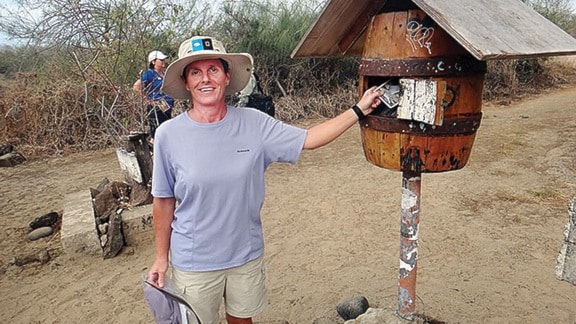Chemainus Secondary School’s intrepid adventurer, Janet Ruest, is living her dream in the Galapagos Islands this week, touring aboard the National Geographic Endeavour as a Grosvenor Teaching Fellow.
When she and fellow Fellow Nicole Means from Louisiana flew in to San Cristobal Island on Saturday, Sept. 12, they saw the ship anchored in the bay.
It didn’t take long for the adventure to begin.
“While waiting to board the ship we came across two sea lions (not seals), lying on a bench on the waterfront esplanade. Not a care in the world and certainly not frightened of humans... More sea lions were sunning themselves on the rocks immediately below the walkway and many Sally Lightfoot crabs with their colourful shells decorated the unoccupied rocks. Two green turtles played in the water below...frigate birds flying over the ship, six foot wing span,” she reported on her blog of the trip at http://jrsjourneys.weebly.com
And they weren’t even officially on the ship yet. They were welcomed aboard Endeavour by the Galapagos handshake — grabbing the wrists of two crew members to get out of the Zodiac — met their expedition leader and had their first briefing.
The next day they arrived at Espanola Island where they got their first taste of snorkeling, Galapagos style.
“Fabulous colours of fish, sea lions who played around our group and then I spotted a rock that seemed to ‘grow wings’ as I swam overhead. A massive ray revealed himself to our delight.”
Her early tour experiences with the wildlife have already shown Ruest she’s not in Chemainus anymore.
“’Wild’ animals who stay near humans have usually become habituated and have lost their fear...the opposite process has taken place in the Galapagos. The birds and animals have never had a fear of humans and therefore do not flee. On our walk this afternoon, marine iguanas continued to sun themselves without the slightest worry as we walked within a few feet. Nazca boobies — a bird the size of a very large seagull — did not take to the skies in fear, they simply watched us taking pictures of them. Waved albatrosses flew overhead and appeared to be purposely providing fabulous photo opportunities.”
Back aboard ship at sunset, she enjoyed the evening discussion with one of the experts and saw some of the photos taken that day by naturalist Juan Carlos.
Ruest said a highlight of her day was seeing some of Darwin’s famous finches coming right up and “pecking at my runners.”
By Monday, Sept. 14, the expedition had reached Floreana Island and some participants began with a long and fast-paced hike, others looking to expand their photographic skills went on a slower hike with a photo instructor while still others brought their sketch pads for hands-on sketching with another expert.
They learned about the colourful history of Floreana, which is now home to only 160 permanent residents.
Their hike led them past nests left by green sea turtles and they got to see flamingos, which “derive their pink tints from the crustaceans they eat, who in turn get their coloration from the shrimp that they eat.”
They also saw colourful blue-footed booby birds diving around them searching for a morning meal.
They circled the Champion Islet preserve by Zodiac, observing how the distinctive flows of lava created provide nesting sites for many birds in a landscape that included many prickly pears. Snorkeling or viewing through a glass-bottom boat showed them a great variety of fish as well.
After lunch, they visited the Pacific’s oldest postal system, Post Office Bay: a barrel set up for postal delivery by British whalers, which involved no postage.
“Whalers would take the post cards from their local area and hand deliver them to the intended recipients. Imagine how the recipients must have felt receiving a post card from the Galapagos years after it had been written,” she said.
Ruest “sent” a postcard to Chemainus Secondary, saying she’d be fascinated to see if and when it arrives. Her adventure continues this week so check out her blog to see pictures and read more of her adventures.
